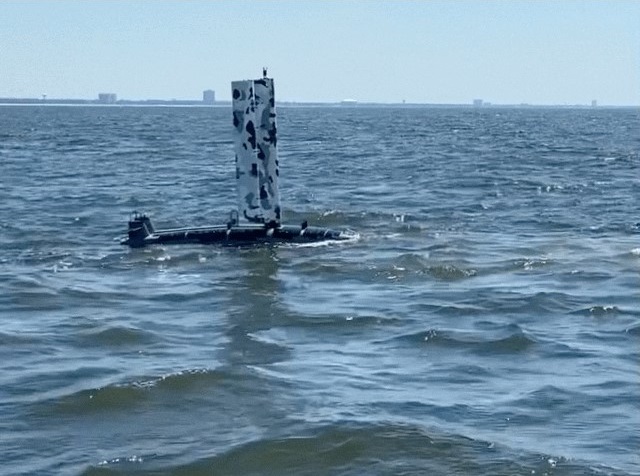For our colleagues at the U.S. Coast Guard (USCG), safeguarding the more than 95,000 miles of U.S. maritime border shoreline and 15,000 miles of waterways, seaports, and other commercially navigable waters is a monumental task. They are vital conduits for trade and travel, critical to our national security.
That’s why the Science and Technology Directorate (S&T) is working with the USCG to identify new technologies to help navigate some truly unique challenges—above and below the surface.

An autonomous Triton vessel navigates through the waters of Gulfport, Miss., as an expert evaluation team (S&T, the Coast Guard, Ocean Aero, CNSP, NRL, ARL, HSSEDI and USM) tests the capabilities of Triton's wind sails, solar panels and other specialized systems to see how well they perform in various ocean conditions. DHS photo
“Our shoreline and waterways face daily threats. Smugglers utilize them for their criminal activity. Natural and man-made disasters, and poaching of maritime wildlife also cause harm,” said Shane Cullen, program manager in S&T’s Office of Mission and Capability Support. “Oftentimes, these threats manifest themselves out at sea—far away from our coast and ports. They represent significant security challenges, so it’s important we have appropriate ocean surveillance technologies that can quickly and accurately detect, track, and identify these threats.”
Thanks to a multimillion dollar appropriation from Congress, S&T initialized a project with the USCG, the University of Southern Mississippi (USM), the U.S. Naval Research Laboratory (NRL), the Applied Research Laboratory (ARL) at Pennsylvania State University, Cherokee Nation Strategic Programs (CNSP), and the Homeland Security Systems Engineering and Development Institute (HSSEDI). The goal — develop, acquire, evaluate, and test six specialized, environmentally-powered (wind and solar), multimission-capable unmanned surface and underwater vessels, with the hope they will eventually serve as valuable tools that will complement the USCG’s existing fleet of ships and aircraft.
These vessels, designed by industry partner Ocean Aero Inc., have been aptly named “Triton.”
“We currently utilize a variety of manned vessels, and both manned and unmanned aircraft, to actively and passively patrol and monitor the oceans and shore surrounding the U.S.,” explained Scott Craig, USCG unmanned systems research and development domain lead. “And while our current fleet enables us to keep an eye on most of it, autonomous ocean surveillance systems have the potential to add another layer of technology to help us significantly increase and strengthen our marine domain awareness capabilities.”
There are already several autonomous vessels in the field utilized for both commercial and military applications. However, the Tritons are a unique technology. At 14 feet long, they are the size of a small rowboat—making them easy to deploy from any port or USCG vessel. They are environmentally friendly and rely solely on wind and solar power at sea. The Tritons’ solar arrays are positioned atop their hulls, along with retractable 8-foot wind sails—both designed to charge the Tritons’ batteries whenever they are on the surface of the ocean. The Tritons also perform surface and underwater surveillance activities; navigate while submerged; dive to about 100 feet; and accommodate state-of-the-art sensor packages that utilize electro-optical and infrared cameras, sonar, and other specialized sensors. All of these characteristics and abilities make them useful for long-term USCG maritime protection and law enforcement operations at sea.
“We’re excited to test the capabilities of these unique vessels in the field,” said Cullen. “We recently completed acceptance testing of the Tritons at USM’s Marine Research Center in Gulfport, Miss. We utilized their specialized facilities to evaluate the vessels’ capabilities in multiple areas, including navigation, surface, diving, and subsurface operations. We evaluated their ability to operate effectively for long periods of time using only wind and solar power, and how well they can serve as a platform for cameras and advanced sensors designed to detect relevant anomalies and threats.”
With acceptance testing completed, S&T, USCG, Ocean Aero, CNSP, NRL, ARL, HSSEDI, and USM’s evaluation team are putting the Triton vessels through a series of rigorous tests to see how well they perform in various ocean environments and conditions. Once concluded, the evaluation team will begin integration tests. Sensor packages will be attached to the vessels, which will then be sent on simulated USCG missions, including:
- Law enforcement activities—detecting and tracking small vessels and submersibles, and relaying relevant information back to USCG operators on shore;
- Environmental and pollution monitoring—measuring the health of the water column, detecting man-made pollutants such as oil spills, etc.; and
- Fisheries protection—ensuring the overall health of fisheries, protecting local wildlife, and detecting illegal fishing.
“Integration testing is the most important of all the assessments,” explained Craig. “It allows us to see how the Tritons dive and perform with the sensors, whether or not the sensors work effectively in the field, and what changes and tweaks may need to be made to these vessels in order to optimize their performance during long-term stays at sea. Most importantly, we are learning how useful Tritons are for USCG’s various operations at sea.”
Integration testing of the Tritons is expected to go on for at least a year.
Department of Homeland Security (DHS)
Science and Technology Directorate (S&T)
Washington, D.C.




